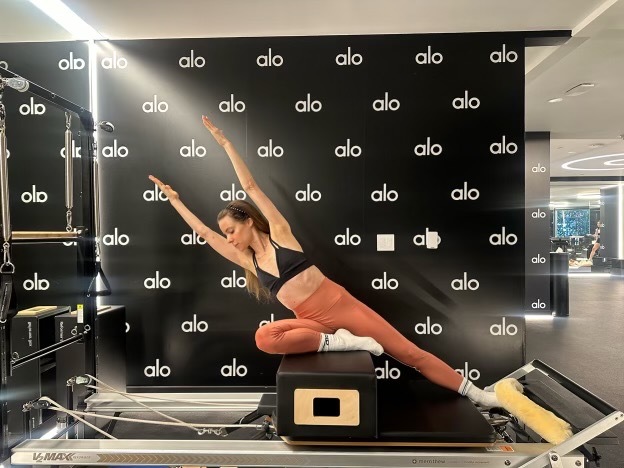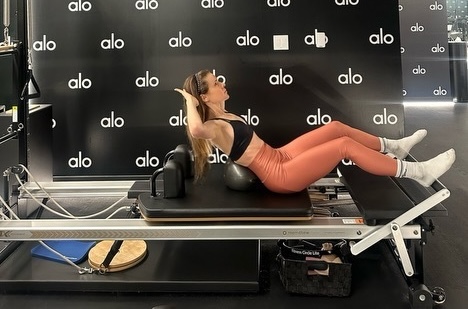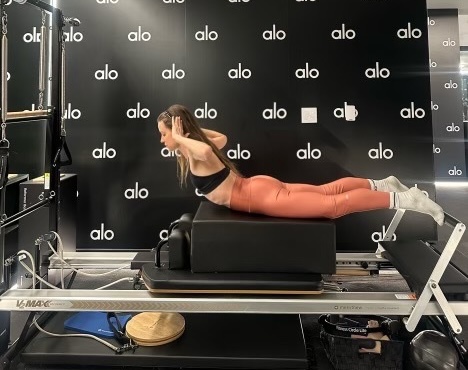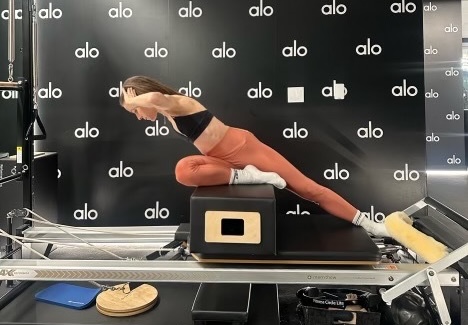These Are the Most Effective Pilates Moves for Every Muscle in Your Core
“Every Pilates exercise is a ‘core’ exercise,” says Laura Quinn, CPT, the head Pilates trainer for Alo Moves and at Alo Wellness Club in Los Angeles. “Joseph Pilates' school of thought [was] when the powerhouse (core) is strong, the rest of the body will follow.”
Modern-day research backs him up. Because a strong core helps to stabilize your spine and pelvis, it can improve your posture1 and balance2, take pressure off your lower back3, reduce your risk of injuries4, and just generally make you more efficient5 in nearly any activity you like to do.
- Laura Quinn, CPT, certified personal trainer and head Pilates trainer for Alo Moves and at Alo Wellness Club in Los Angeles.
Pilates is an especially efficient way to work this part of the body because all the exercises are designed as controlled, low-impact movements with a focus on the breath and incredibly close attention to form.
Pilates is an especially efficient way to work your core.
“In other modalities, it’s easy to let bigger muscle groups take over instead of fully activating the core, but in Pilates exercises, the only option is to learn true core engagement,” says Quinn. So if you’re looking to strengthen your core, Pilates can be one of the best ways to go about it.
The most effective Pilates moves for your core muscles
Although experts disagree on exactly which muscles make up the core, it’s safe to say that the biggest players include the obliques (on the sides of your trunk), the rectus abdominis (the “six-pack” muscles), the erector spinae (along your spine), the transverse abdominis (a deep band of muscles that wraps around the trunk), and the pelvic floor (a hammock of muscles between your tailbone and public bone).

{{post.sponsorText}}
So which are the most effective Pilates moves for each of these primary core muscles? Every teacher has their own favorites, but Quinn shares her personal top picks.
For the obliques: Mermaid Dips
Quinn likes to work the obliques with side-bending mermaid dips. These can be done on the reformer or on a mat at home.

- Sit on the floor or on a box on the reformer, with your right leg bent and tucked in front of you. If you’re on a mat, bend and tuck your left leg just behind you; on the reformer, you can point it straight to the side and rest it on the platform below for extra leverage.
- Reach both hands straight up to the ceiling. Keep your ribs flat (don’t splay them out), and lift up out of your waist while keeping your shoulders down.
- Slowly reach over to the right side, lengthening your spine and keeping your hips grounded.
- Use your obliques to lift back up to center.
- Do 8 to 10 reps, then switch sides.
For the rectus abdominis: Pilates Mini Ball Crunch
“Exercises incorporating the Pilates ball are my favorite to target the rectus abdominis,” Quinn says. “You can do this by adding the ball between the thighs, knees, or under the sacrum or shoulders. You’ll feel each one differently but intensely!” One of her go-tos is a crunch with the ball under the low back.

- Sit on your butt with your knees bent and feet flat in front of you. Place a small Pilates ball just behind your back, and put your hands behind your head.
- Sink back into the ball so that your torso is leaning back on an angle.
- Inhale to extend further over the ball, then exhale to lift up in a crunch.
- Do 8 to 10 reps, rest, then repeat with another set.
For the erector spinae: Superman
Superman is one of the most effective Pilates moves for the back. It can be done on the mat, or you can hop on a reformer for an additional challenge, using your hands in the straps with spring resistance.

- Lie down on your stomach, with your legs extended long behind you and both hands stretching straight overhead. You can be on a mat on the floor or on a long box placed on the reformer. Place your hands behind your head, pull your shoulders down, and keep your chin tucked.
- Lift your right arm and left leg up off the floor, without crunching into your lower back.
- Hold for a second, then release.
- Repeat on the other side, with the left arm and right leg.
- Do 8 to 10 reps, alternating sides.
- Then, lift both arms and legs at the same time for another 8 to 10 reps.
For the transverse abdominis: Mermaid Dips With a Twist
To get to this deep core muscle that wraps around the trunk, Quinn recommends adding a twist to your mermaid dips.

- Sit on the floor or on a box on the reformer, with your right leg bent and tucked in front of you. If you’re on a mat, bend and tuck your left leg just behind you; on the reformer, you can point it straight to the side and rest it on the platform below for extra leverage.
- Reach both hands straight up to the ceiling. Keep your ribs flat (don’t splay them out), and lift up out of your waist while keeping your shoulders down.
- Slowly reach over to the right side, lengthening your spine and keeping your hips grounded.
- Twist your shoulders to face the floor. Hold for a second, then turn back to the front.
- Use your obliques to lift back up to center.
- Do 8 to 10 reps, then switch sides.
For the pelvic floor: Standing Light Spring Series
As long as you’re not pregnant, Quinn says one of the best ways to engage and find release in the pelvic floor is to target the inner thighs with a standing light spring series on the reformer.
“The inner thigh connects to the pelvic floor,” she explains. No reformer? Try replicating this series with gliders.

- Stand with one foot on the platform, and one on the moving carriage. Hold your hands together in front of you for balance. Point your feet straight ahead to keep the legs parallel.
- As you bend down into a wide squat, allow the carriage to slide out to the side.
- Use your inner thighs to bring the carriage back toward the platform as you stand up.
- Do 8 to 10 reps, then switch sides.
What results can you expect?
Doing these exercises regularly will help your core grow stronger and more stable. If you can do a full Pilates session three or four times a week, you’ll likely see some results pretty quickly. “However, incorporating a quick 10-minute core workout daily can also be beneficial,” says Quinn.
Bonus: By strengthening your core with the most effective Pilates moves, you’ll start to see improvements in your other workouts, too. In particular, Quinn calls out “proper breath and core activation with heavy lifts, or proper form when running.” Just don’t forget to thank Mr. Pilates when you hit a new PR.
- “The Effect of Core Training on Posture”. Academic Journal of Interdisciplinary Studies, vol. 4, no. 1 S2, May 2015, p. 221, https://www.richtmann.org/journal/index.php/ajis/article/view/6357.
- Jo, Sun-Ha et al. “Effect of Core Balance Training on Muscle Tone and Balance Ability in Adult Men and Women.” International journal of environmental research and public health vol. 19,19 12190. 26 Sep. 2022, doi:10.3390/ijerph191912190
- Smrcina, Zachary et al. “A Systematic Review of the Effectiveness of Core Stability Exercises in Patients with Non-Specific Low Back Pain.” International journal of sports physical therapy vol. 17,5 766-774. 1 Aug. 2022, doi:10.26603/001c.37251
- Al Attar, Wesam Saleh A, and Mohamed A Husain. “Effectiveness of Injury Prevention Programs With Core Muscle Strengthening Exercises to Reduce the Incidence of Hamstring Injury Among Soccer Players: A Systematic Review and Meta-Analysis.” Sports health vol. 15,6 (2023): 805-813. doi:10.1177/19417381231170815
- Luo, Shengyao, et al. “Effect of core training on skill performance among athletes: A systematic review.” Frontiers in Physiology, vol. 13, 6 June 2022, https://doi.org/10.3389/fphys.2022.915259.
Loading More Posts...